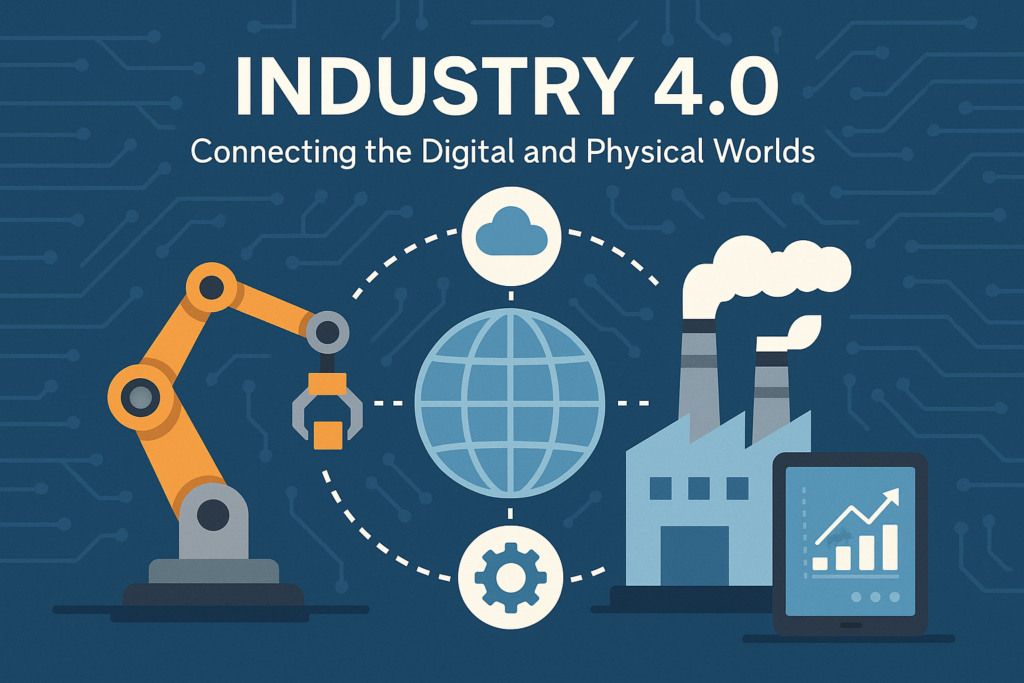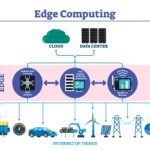Introduction to Industry 4.0
Industry 4.0 marks the fourth industrial revolution, where smart technologies—IoT, cloud computing, and big data—fuse to reshape manufacturing. This post explores the core components, real-world applications, key benefits, implementation challenges, and future trends that define this transformative movement.
1. What Is Industry 4.0?
Industry 4.0 refers to the cyber-physical integration of manufacturing systems using rapid digitalization. Think of physical assembly lines equipped with sensors, robots, and analytics platforms connected through the internet and cloud.
Key pillars include:
- Internet of Things (IoT) – tons of connected devices, machines, and sensors.
- Cloud & Edge Computing – scalable compute and real-time response power.
- Big Data & Advanced Analytics – massive data processing and intelligence.
- Digital Twins – virtual replicas of real-world assets.
- AI / Machine Learning – predictive insights, automation, and optimization.
This synergy enables factories to sense, analyze, and adapt autonomously.
2. IoT: The Neural Network of Smart Manufacturing
IoT (Internet of Things) underpins Industry 4.0 by linking physical equipment to digital platforms via networks.
- Smart sensors collect data on temperature, vibration, machine health, throughput, quality defects.
- Connected Robots (Cobots) collaborate with humans and factory systems.
- Wireless protocols (Wi-Fi6, 5G, LPWAN, industrial Ethernet) ensure real-time communication.
Real-World Example
A German automotive plant implemented IoT vibration sensors on CNC machines. These sensors transmitted anomalies to cloud systems, enabling predictive maintenance—cutting unplanned downtime by 30%.
This illustrates the transformation from reactive to proactive maintenance, thanks to IoT linking devices to data hubs and allowing remote diagnostics.
3. Cloud & Edge: The Dual Engines of Processing
Cloud computing offers large-scale storage and advanced analytics capabilities; edge computing handles latency-sensitive tasks near the machine floor.
Cloud Benefits:
- Elastic Storage & Compute: Easily manage terabytes of sensor data.
- Centralized Data Integration: Aggregate production, supply chain, and quality info.
- Managed Services & Security from cloud providers boost uptime and compliance.
Edge Benefits:
- Ultra-low latency: Robots and safety systems need sub-millisecond responses.
- Bandwidth Efficiency: Edge processing reduces the amount of data sent to the cloud.
- Autonomy: Edge systems ensure continuity even if connectivity drops.
Balance:
A modern plant may deploy edge gateways to preprocess sensor data and transmit summaries or exceptions to the cloud.
4. Big Data & Analytics: Mining Intelligence from Data Lakes
Sensor and operational data fuel a multi-petabyte data lake, unlocking deep descriptive, predictive, and prescriptive analytics:
- Descriptive Analytics: Real-time dashboards for OEE, cycle times, quality metrics.
- Predictive Maintenance: Using ML to forecast failures before they happen.
- Prescriptive Optimization: AI models run “what-if” scenarios to minimize waste, optimize energy, or adjust schedules.
Case Study
A US electronics manufacturer used big data analysis to optimize energy consumption across shifts—saving up to 12% on utility bills while maintaining output.
5. Digital Twins: Mirror Worlds for Smarter Manufacturing
Digital twins are dynamic virtual models—mirroring real equipment, lines, or entire plants.
How they work:
- Physical sensors stream data in real time to digital models in the cloud or edge.
- Engineers simulate scenarios like shifts in throughput or maintenance sequences.
- The system recommends actionable updates to machine parameters or schedule changes.
Benefits:
- Detect anomalies faster
- Reduce downtime
- Support training and remote troubleshooting
- Accelerate new product ramp-up
6. Synergy in Action: A Holistic Use Case
Scenario: Smart Packaging Line
- IoT sensors track fill levels, conveyor speed, and label quality.
- Edge units conduct real-time anomaly detection.
- Data is batched and uploaded to cloud platforms.
- Cloud analytics fine-tune target throughput and energy scheduling.
- A digital twin verifies proposed line changes.
- Operators receive real-time dashboards and alerts.
Impact: yield increases by ~15%, scrap is reduced by ~20%, and maintenance costs drop.
7. Key Benefits of Industry 4.0
- Increased Productivity & Flexibility: Preventing downtime and supporting on-the-fly adjustments.
- Lower Operational Costs: Reduced waste and optimized energy usage.
- Enhanced Quality Control: Sensor-based inspection reduces defects.
- Data-Driven Decision-Making: Real-time insights drive agile manufacturing.
- Workforce Empowerment: Workers are upskilled to operate and interpret smart systems.
8. Implementation Challenges and Trade‑offs
| Challenge | Details & Solutions |
|---|---|
| Legacy Systems Integration | Must retrofit sensors and connectors to older machinery |
| Security & Data Privacy | IoT introduces new attack vectors—need secure architectures |
| Skill & Culture Shift | Workers must adapt to data-driven roles |
| ROI Measurement | Clear KPIs required (e.g., TCO, OEE improvement, scrap rate) |
| Standardization | Need unified data models and interoperability between PLCs, SCADA, MES |
9. Security & Governance in Smart Manufacturing
- Secure-by-design devices, hardware-based encryption
- Zero-trust architecture for machine authentication
- Software supply chain auditing
- GxP/regulatory compliance, including ISO 27001 / IEC 62443
- Anomaly detection systems that flag unexpected traffic or behavior
Manufacturers must view cybersecurity as foundational—not optional.
10. Human & Organizational Transformation
- Upskilling programs train workers in IoT, data analytics, and AI tools
- Cross-functional teams empower faster troubleshooting
- Leadership must steer toward digital-first mindsets
- Change-accelerator roles help integrate new processes in established factories
11. Future Trends Shaping Industry 4.0
- 5G/6G Networks: Ultra-low latency, higher device density
- Augmented Reality (AR): Maintenance techs viewing sensor overlays via AR glasses
- AI-optimized Supply Chains: Dynamic reprioritization and route adjustments
- Decentralized AI & Blockchain: Secure, traceable supply chains and multi-party manufacturing
- Green & Circular Manufacturing: Monitoring carbon footprint, enabling eco-design of recycling-ready products
These emerging technologies will deepen the Industry 4.0 transformation.
12. Practical Roadmap to Industry 4.0 Adoption
- Pilot Project Selection: Choose a clear problem (e.g., cycle time, energy)
- Baseline Measurement & KPIs (OEE, scrap, MTTR, energy per unit)
- Design Architecture (IoT devices with edge-to-cloud pipelines)
- Pilot Deployment & Iterate (KPIs tracked, model refined)
- Scale Factory‑wide (deployment, training, data integration)
- Continuous Optimization via digital twins, monthly reviews
13. Measuring Business Impact
- OEE: Overall Equipment Effectiveness
- MTBF/MTTR: Mean Time Between/To Repair
- Throughput & Lead Time: Faster turnarounds
- Quality Yield & Scrap
- Energy / Utility Cost per Unit
- Employee Satisfaction & Skill Index
Define goals up-front and ensure monthly value reviews during rollout.
14. Conclusion: The Path Forward
Industry 4.0 redefines manufacturing from reactive, siloed, physical systems into agile, intelligent cyber‑physical factories. The integration of IoT, cloud, and big data delivers proven value in uptime, quality, cost, and sustainability.
Companies that embrace this transformation today will gain a competitive edge in agility, resilience, and
Gourav Maheshwari
Compiled Successfully Software Solution
📧 CompiledSucessfully@gmail.com
📞 +91 92209 22267
https://compiledsuccessfully.in






Leave a Reply